Epoxy coatings are a great flooring choice for a wide variety of applications, they are durable and almost completely trouble-free. They can be very attractive, hygienic, easy to maintain. And there is an incredibly wide range of finish options from Solid colors, Flake, Quarts, Cementitious even beautiful Metallic finishes like the one below.
And as a contractor, you can make an embarrassing amount of money applying them, along with a real sense of accomplishment when you create what really is artwork that you walk on, as seen below.
 Metallic epoxy by Elite Crete Systems
Metallic epoxy by Elite Crete Systems
But there is a dark side to Epoxy floors, which is...
If you don’t know what you're doing you can really mess it up!
Yes, epoxy floors are easily “messed up” but the good news is that if you will keep in mind the 8 reasons they can fail and address those reasons you can be confident that your applications will be successful, and that success will show in your profitability.
Let’s cover them one at a time.
1. Failure to get the necessary training
Every epoxy manufacturer wants you to succeed, their reputation and profitability depend on you being successful. And they do everything they can to help you succeed. Part of what they do is give you detailed instructions for a successful application. Read those directions, understand them completely before starting a project!
Some epoxy manufacturers will not even sell you their material until they know that you have a detailed understanding of how to apply their product. With these companies, you must be certified (factory-trained) this is of great value to the applicator because the manufacturer teaches you to apply their specific product.
Here’s another good point: when a manufacturer develops a product, part of the process is that THEY make all the mistakes, and they learn from all the failures. Their training teaches you how to avoid those mistakes. This information is priceless! And another great value is when you are certified you have access to their Tec-Reps— experts in applying their materials—so that if you have questions or problems they are there to help.
Here is a great example...
I am the product trainer for Bartell Global. We manufacture Surf-Prep equipment like planetary diamond grinders and shotblasters that are used in preparing concrete surfaces for epoxy coatings. I participate in an ongoing training program here in the Northwest part of the US that is put on by a really experienced epoxy manufacturer… Elite Crete Systems, (they do this all over the US) I will demonstrate our equipment and cover the importance of Surf-Prep and JR & TY (a couple of colorful characters) will teach and certify the attendees on their epoxy products. They take the time and spend the money to train these applicators because they have confidence in their product! But they also understand how easy it is to “mess it up” and have a failure. They understand that good training prevents failures.
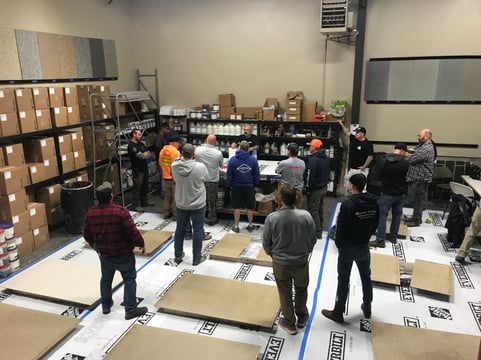
Here is what, as a product trainer, I see as critical: You can manufacture the best equipment or the best epoxy coating but if a contractor is not trained to use that equipment correctly or apply that epoxy coating properly, you end up with disappointment.
Here’s another interesting point about Elite Crete training:
when I am there, (I have participated in probably 6–8 training days in the last year) I see the same contractors repeatedly. Why? Because they come for refresher courses, those contractors understand the importance of not just the initial training but ongoing reaffirmation of the process! It's THAT important.
In the Elite Crete classroom where JR Litehiser and TY Clark teach, they have a chalkboard behind them with large bold letters: (Sorry JR & TY, I did have to clean it up a bit ;-)
R.T.I.
READ THE INSTRUCTIONS!
All manufacturers provide directions physically, on the buckets themselves, and in paper form, as well as electronically. It is critical to keep these directions and refer to them… R.T.I.!
The applicator that “Shoots from the hip” is destined for failure.
Are Elite Crete, JR and TY unusual? By no means! There are many great epoxy manufacturers out there and provide their version of this training, and physical directions, and it is critical that applicators take full advantage of this provision.
2. Poor Surface Preparation
Preparing the surface just can’t be emphasized enough!
Correct floor prep is comparable to the foundation of a new house. Think about this. When you build a house, it does not matter if you put the best roof on this house, installed high-end cabinets, really nice millwork, the best windows available or anything else if you have first installed a faulty foundation. The house will fail.
Like that house, you can have the best coatings material and it will fail if you have not correctly prepared the concrete substrate to accept the epoxy.
Most contractors will use a planetary diamond grinder or a shot blaster like the ones shown below to profile the floor to the correct CSP (Concrete Surface Profile) to accept the epoxy. Where do we find the correct CSP? JR would say… R.T.I.!!!, read the label, the instructions, they will be there, all manufacturers will tell you what the profile of the concrete must be.
For more information on CSP (Concrete Surface Profile) CLICK HERE
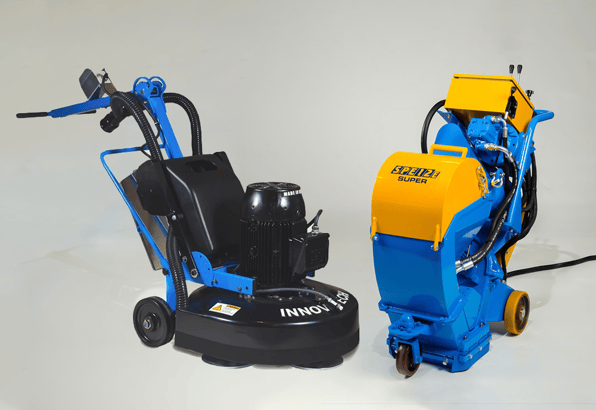
When choosing a machine to profile a floor my general rule of thumb is,
- Thin mill epoxies = Use a Planetary Diamond Grinder
- High build epoxies = Use a Shotblasters
3. Wrong Primer or NO Primer

Epoxy flooring systems are called “systems” because there is more than just the epoxy coating itself needed for a successful outcome. Primer is critical because it provides an intermediary, high-strength bonding layer.
So, always…
- Use the correct primer.
- Mix the EXACT correct mix ratio and mix correctly.
- Don’t get in a hurry. If the directions say “mix for 5 minutes” ... mix for 5 minutes.
- Apply only under the correct conditions, temp, moisture, lighting, etc.
- Apply primer to the correct “Spread Ratio”
Where is this information found?.… R.T.I….
4. Incorrect Resin/Hardener Mix
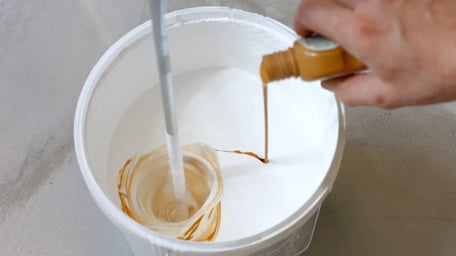
This is another point that just cannot be emphasized enough! If you have the incorrect mix ratio or a mix that is not thoroughly blended you WILL get failures. When mixing you MUST do the following…
- Never approximate, guess, use the EXACT correct ratios... R.T.I.
- Never “hand mix” always use an electric mixer and the correct mixing paddle.
- Again, don’t rush! If the directions say “mix for 5 minutes”... mix for 5 minutes.
- Have a dedicated mix station and a dedicated mixer.
- Never pour mixed material out of the mixing container onto the floor. Always transfer material from the mixing container into a clean bucket to deliver to the floor. This avoids the possibility of inadvertently applying a portion of unmixed material to the floor. Buckets are cheap! Especially compared to replacing an epoxy floor.
This is an area where there can be NO guesswork, I have talked with a lot of applicators and they agree:
“I will have my crew profile the floor, run the gauge rake, the spike roller, but NO ONE MIXES BUT ME!” Why? Because correctly mixed product is just that important.
Here's why... If you place a 2,000 square foot floor and you have a one square foot section that was not mixed properly, it's sticky and won't cure or harden, what’s the fix? The fix is to remove 2,000 square feet of beautiful epoxy flooring, with your diamond grinder and start over! This is really depressing and costly.
Don’t shoot from the hip, use the correct ratios and mix correctly… R.T.I….
6. Weak or Incompatible Substrates

This is where an applicator must use their best judgment. Be very cautious of…..
- Wood floors. Technically, epoxies will often adhere to wood but most epoxies are ridged and will not flex and most wood floors do flex and there is a high likelihood that the coating will crack and fail.... are there exceptions to this? Yes. We are just saying, be very cautious when accepting this kind of project.
- Lightweight concrete, gypsum-based floors. Again primers and epoxies will adhere (most of the time) but there is just not enough structural integrity with these materials and in most cases, it would be a mistake to apply epoxy.
- Low-quality cement. The primers and epoxy will adhere to these substrates but the concrete will not adhere to itself, flaking off and failing. The result is a ruined floor.
Be prepared to walk away from a project that has a high risk of failure.
Remember, even if the customer offers to “sign off” and take responsibility for an unacceptable substrate, it is a really bad idea to proceed with the project. The reason is this: if there is a lawsuit over a failed epoxy floor, in the USA and most other countries, YOU will be responsible. Why? Because in court, YOU are the professional, you know better, it is your job to know better and you installed it anyway. Customers don’t know better, they are NOT expected to know better. This is serious and happens often. So...

Walk away from a risky install.
7. Contaminated Floors
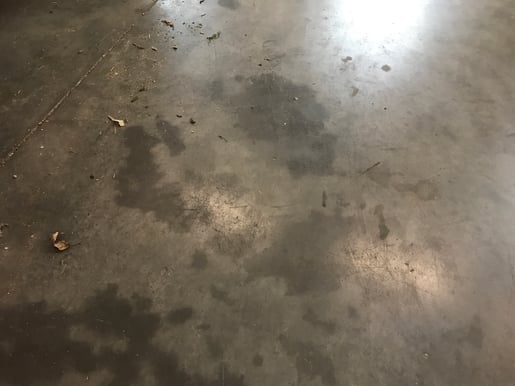
Oil contaminated slab
A big mistake that guarantees a failure is installing over a contaminated floor, one that has grease, oil, paint, wax, or chemicals on and IN the surface of the slab. Any of these substances would be considered a “Bond-Breaker”, which refers to anything that interferes with the adhesion of the epoxy floor with the concrete slab.
When applying an epoxy coating It is important to be working with only THREE MATERIALS, The concrete, primer, and the epoxy. If you are not sure if a floor is acceptable, what do you do? “R.T.I.”
8. Failure to Control Moisture (in the slab and air)
Moisture in the slab, or moisture migrating through the slab (moisture vapor transmission) is the death of epoxy floors and must be dealt with or an adhesion failure is highly likely.
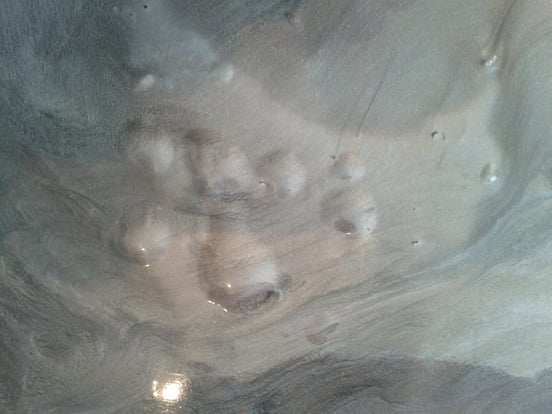 Failure due to moisture
Failure due to moisture
First, for MVT, it is critical that you do moisture tests to the slab with either a Calcium Chloride or in-slab Relative Humidity test and if necessary, mitigate if the readings are too high. Most manufacturers will have "moisture barriers" that you can install first to mitigate the presence of moisture.
Where do you go to find out the acceptable amount of moisture in a concrete slab for the epoxy manufacturer to warranty their material? It will be different with various manufacturers, but all manufacturers will have that information on the label, instructions. R.T.I.!
Another way moisture is introduced to the slab can be through “wet” grinding and auto-scrubbing the slab prior to the epoxy application.
First, it is recommended that you “dry” grind the slab when prepping it and not auto-scrub the floor but vacuum the debris with a Hepa filter vac system. Do a very good job with the vac, dust is a huge “Bond-Breaker”. If you dry grind, it is imperative that you remove ALL the dust from the pores of the slab. (See #3 about the dangers of bond-breakers as dust is a big one)
Can you wet grind and autoscrub? Yes, you can, but if you do, you must give the slab time to thoroughly dry before continuing. Dry for at least a day in the best of conditions and probably more like three-five days to truly dry the slab.
FOR MORE INFORMATION ON WET VS DRY GRINDING CLICK HERE
So, those are the 8 common mistakes contractors will make when applying an epoxy coating, knowing and avoiding these mistakes puts a contractor in a position to be a successful epoxy applicator and reap the financial rewards.
Here are some examples of great epoxy projects, these images were taken by proud applicators that have learned to avoid those 8 mistakes, ranging from true works of art, to practical, durable showrooms, break rooms, and warehouse floors.

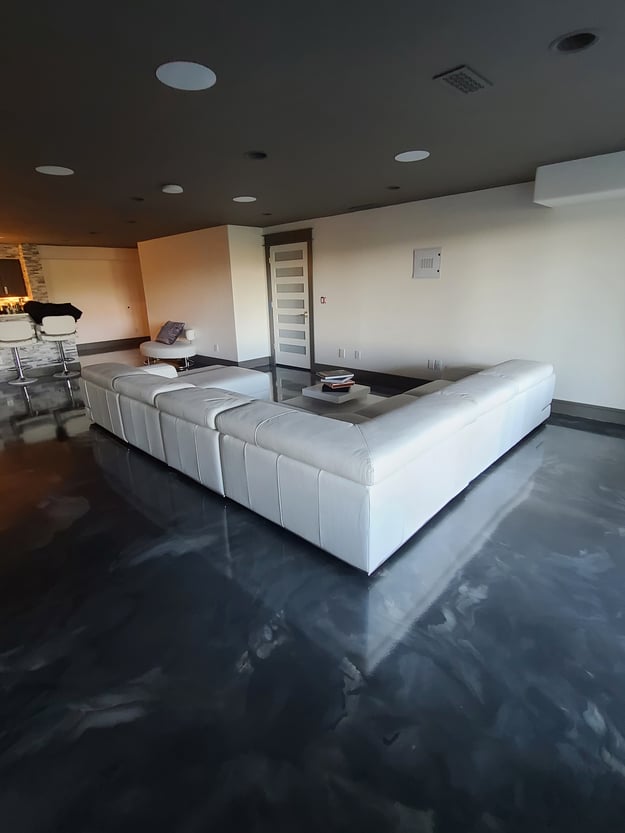
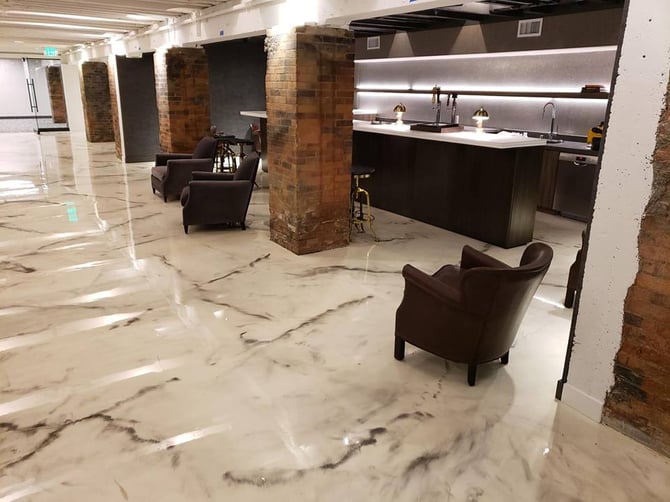


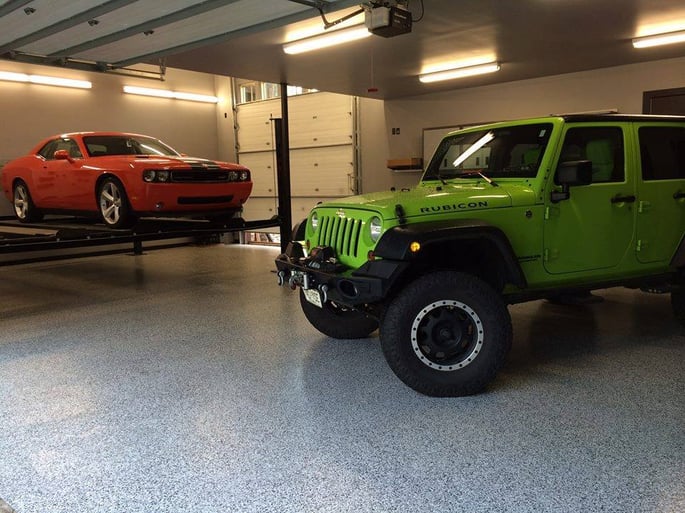
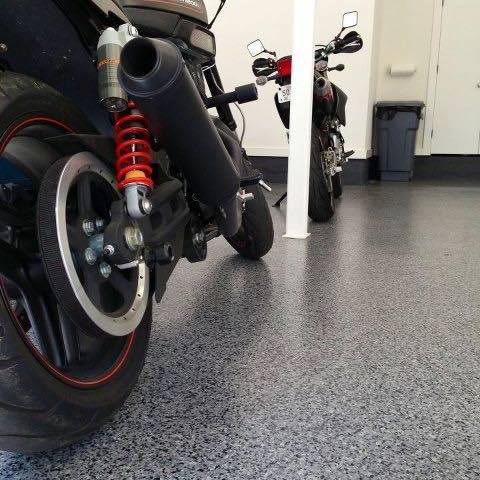

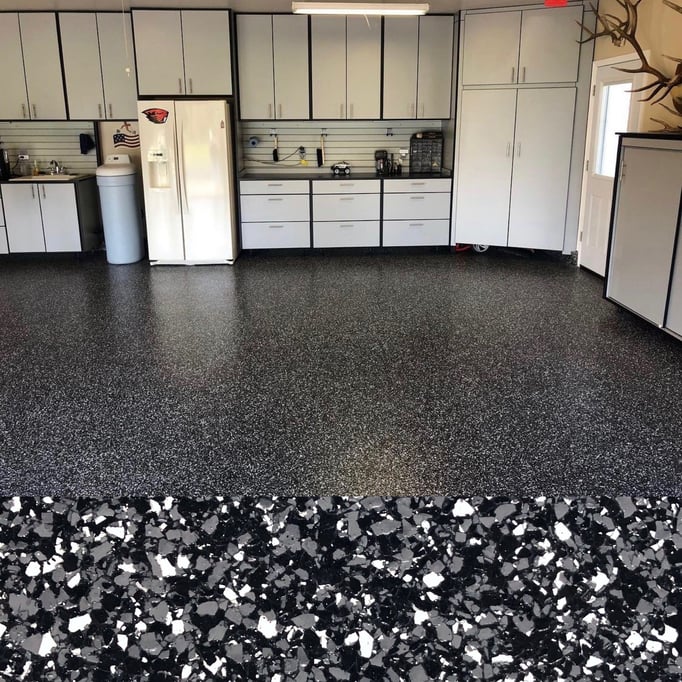

Beautiful floors!
If you have questions about our part of the process, Surf-Prep equipment, contact us at BartellGlobal.com and we will be happy to get you the information you need as well as get you in contact with your local sales rep.


 By
By